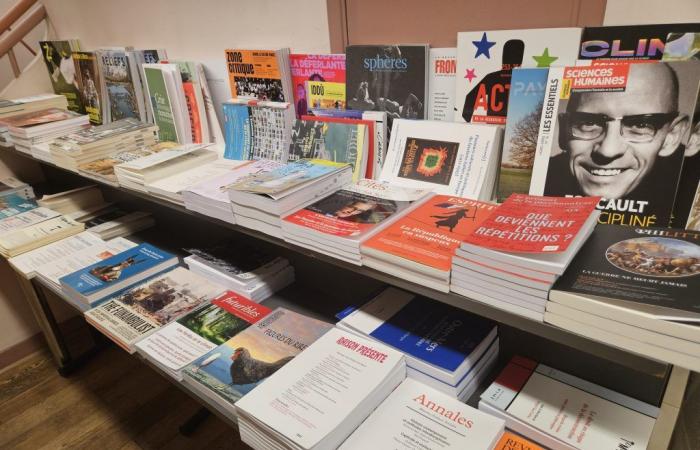How is the magazine market going? At dawn of the 34e Magazine fair, October 11, 12 and 13 at the Halle des Blancs-Manteaux in Paris (IVe arrondissement), its actors generally agree on their difficulty in reaching the readership. “We have to look for the reader today, before it was the other way around”confirms Aurélie Juliadirector of The Revue des Deux Mondes.
It is true that the sector is largely made up of artisanal, personal titles belonging to the university domain. There are also some historical journals benefiting from better distribution, and others backed by publishing houses. Recently the mooks have also participated in the recomposition of the offer.
Keeping Balance
L’association Interviewswhich organizes the Salon de la revue, counts at least 2,500 current French-speaking titles in its continually updated online directory. Created in 1986, it informs and welcomes magazines to the market through permanent monitoring work.
“These are small structures little affected by market trends given their sizeanalyse Yannick Keravecdirector ofInterviews. It is a continuous movement of the market, a perpetual energy. Journals seek a balance and do not rely on external input, it is an economy of resistance. In gaining weight, there is the fear of losing control. »
Their ambition is not commercial but more artistic, fulfilling and focused on creation. Not all authors are paid, which sometimes can make their contributions a hobby and a need to share.
Low print runs
“Journals have long played a role in research, they are laboratories. The authors also cut their teeth there, it is the antechamber of publishing », says Mathieu Mulceypublishing director of The Primera magazine on anti-speciesism and for the animal cause attached to the Eliott house of which he is the founder. Already existing on digital, it published its first paper issue in spring 2024 including an article from Peter SingerAustralian philosopher internationally recognized on the animal question.
With an average print run of between 800 and 1,000 copies, their first issue has sold over 500 units so far. “The financial objective is not to lose money and to stay in balance. The journal has more of an editorial and intellectual purpose. I didn’t count take a hasty retirement thanks to this review »he laughs.
Interviews has around sixty new titles per year. Conversely, it is difficult to keep track of those who stop publishing, as many journals have irregular or even random publication rhythms.
Difficult to classify
In terms of format, paper is taking over digital after the early rise of IT. Some magazines like The Primer become hybrids. A hybridity that is also found in the themes covered and makes the journals difficult to understand by booksellers, who often wonder how to classify them. “They are very reluctant to havecritic Mathieu Mulcey. This adds difficulty to being present and we can see a trend, even if the first issue sold reasonably, I am surprised at the reluctance of booksellers. »
Chez Gibert Joseph, boulevard Saint-Michel (VIe arrondissement), the leading bookstore in France in terms of turnover, the magazines are classified by genre on different floors. The literary ones on the first, the philosophical on the 3rde and the scientists at 5e For example. The bookstore receives 10 magazines per month in the literary section. Placed at the base of a display, they are little highlighted.
At the Compagnie bookstore, rue des Écoles (Paris Ve borough), an entire corridor is dedicated exclusively to magazines, regardless of genre. “It’s a radius that’s only getting smaller. We take 20 copies for the big titles and one or two for more modest ones like those on poetry”explains a seller.
Another obstacle to the sustainability of certain journals: diffusion and distribution. “It’s very complicated to overcome geographical proximity in medium and small townspresents Yannick Keravec. They must tour booksellers and stock at home. There are plenty of complicated business processes to grow, such as postage and shipping costs. »
To enlighten or to be enlightened
We also find this hybridity in The Revue des Deux Mondescreated in 1829. Initially dedicated to travel, it is now aimed at readers knowledgeable about geopolitics and literature. With today nine publications per year, 40,000 subscribers, 5,000 sales per issue for a circulation of 12,000, its finances remain stable. “We try to have a balanced budget. You should know that all our authors are paid”proclaims Aurélie Julia.
In the past, big names in literature signed the pages of the magazine as Victor Hugo, Honoré de Balzac or even Charles Baudelaire and his Flowers of Evil in 1855. The Revue des Deux Mondes continues to welcome writers like Raphael Doanor to converse with others like Kamel Daoud for his novel Houris (Gallimard), selected in several major prizes.
Aurélie Julia nevertheless deplores a lack of visibility on the part of the media for the world of magazines in general. “We no longer have enough support. Dedicated broadcasts on France Culture and Notre-Dame have disappeared, for example. It’s rare that we talk about reviews in the media and I don’t understand this gap. »
The world of the magazine nevertheless continues to exist, with a large ecosystem lurking in the shadows just waiting to be brought to light. The 34e edition of the Salon de la revue in Paris will take on this role for a weekend.






